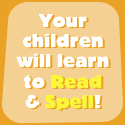

Ben's ABC
Teaching Your Child to Read
Teaching Methods for Reading Skills

The two most widely used teaching methods for reading are the phonics method and the total reading method (whole language). There have been decades of acrimonious debate in the teaching community over which method is best -- the so-called 'reading war'. The proponents of both methods extol the benefits of their system and decry the weaknesses of the other.
At times, the debate has become bitter and personal, raising strong passions from both sides. The die-hards in both camps can be very entrenched in their beliefs. It is good to know they are so passionate about the education of our children, although sometimes it seems like they just want to be right.
In truth, there are positive and negative aspects to both methods.
Total Reading / Whole Language
The total reading method, also known as whole language, is how most adults read. We look at the whole word and we know it. We do not need to phonetically sound out the word in our heads because we have seen it hundreds of times before and we recognise it.
The system's proponents say that since this is how most adults read, it makes sense that children should learn the same way. They say that children will naturally learn the phonetic rules as their reading vocabulary increases. Children are taught to recognize whole words rather than individual sounds. This method gives children quick access to reading skills, which encourages them to progress.
This method is often taught with picture books or flashcards. Simple clear pictures help the child associate the word.
The problem with total reading is the child cannot read new words. If the child does not know the word, she does not have the phonetic skills to put the letter sounds together and deduce the word. The supporters of total reading claim children will learn the phonetic rules naturally. The supporters of the phonics method highly dispute that claim.
Phonics
In the phonics teaching system, the child learns the phonetic rules that form words. They learn the letters of the alphabet and the sounds they make. They then learn to blend the sounds together to form simple words; at, in, on, etc. They then advance to three and four letter words until eventually they can form complex words.
The system's proponents say that learning phonics is the essential basis of reading. Children will naturally drift to scan reading (total reading) as they become older but they will always need the phonics base so they can read new words. Phonics also allows students to make educated guesses at how to spell new words.
There are two main problems with the phonics teaching method. The first is that it can be rather boring for the children. Learning the letters of the alphabet and their associated sounds is a slow and tedious exercise. This is very much down to the ability of the teacher.
The big problem with phonics is that the English language has so many inconsistencies that it just does not work. How do you teach a child phonics but also explain that words as simple as 'do' and 'go' do not rhyme. How do you explain that 'cow' and 'how' do not rhyme with 'low' and 'mow' (which do rhyme with 'go'). How do you explain that the 'g' sound in words like 'gem', 'gel', 'giant' and 'giraffe' does not sound the same as in words like 'get', 'gibbon', 'gift' and 'girl'. There are no phonetic rules to explain these inconsistencies and the English language is packed with them. You just have to know the words.
To teach the phonics method you need books that use regular words that are phonetically consistent. You introduce all the inconsistencies later.
Which Method to Use?
The debate over which method is best continues. Fortunately, common sense has mostly prevailed over teaching dogma. The majority of the world's English teaching community has now come to accept that what they need is a combination of both teaching methods. Students gain a more rounded and solid reading skills base by learning to read with a mixture of both methods. It allows students to develop a complete set of reading skills without the gaps left by learning from a single method. It also helps teachers to keep their lessons varied and entertaining for their students.

